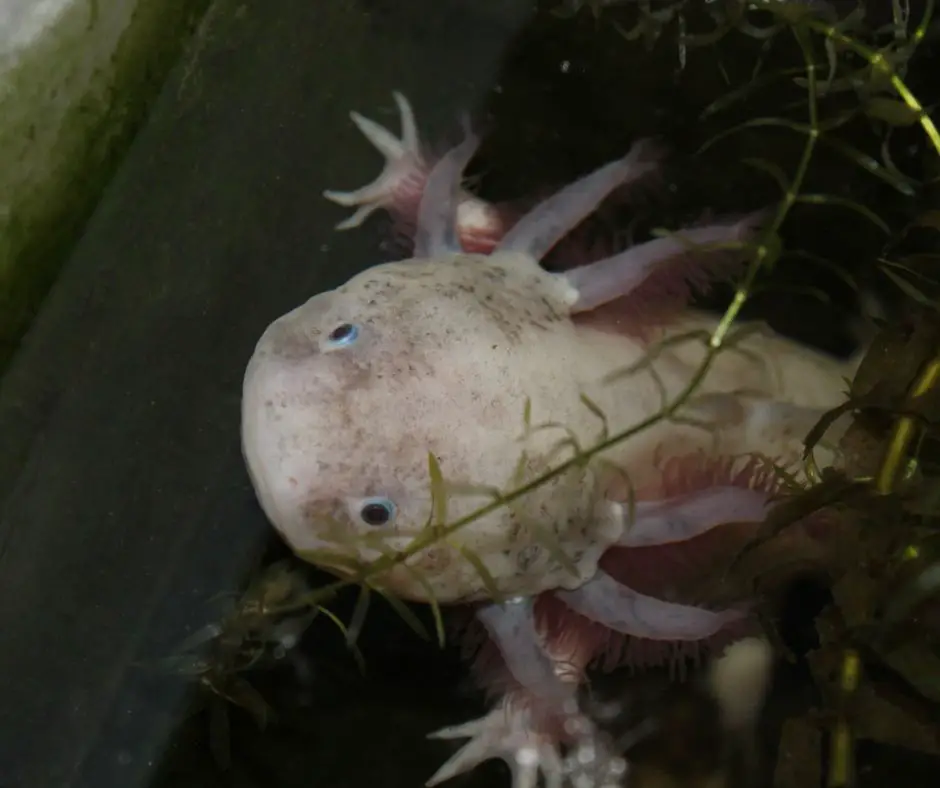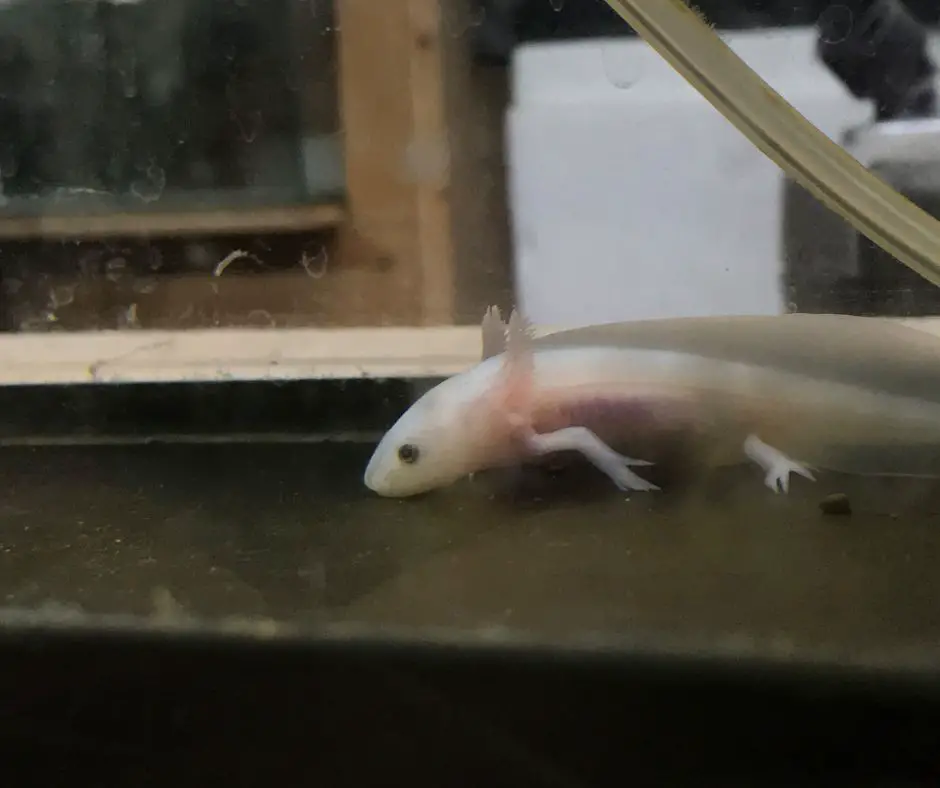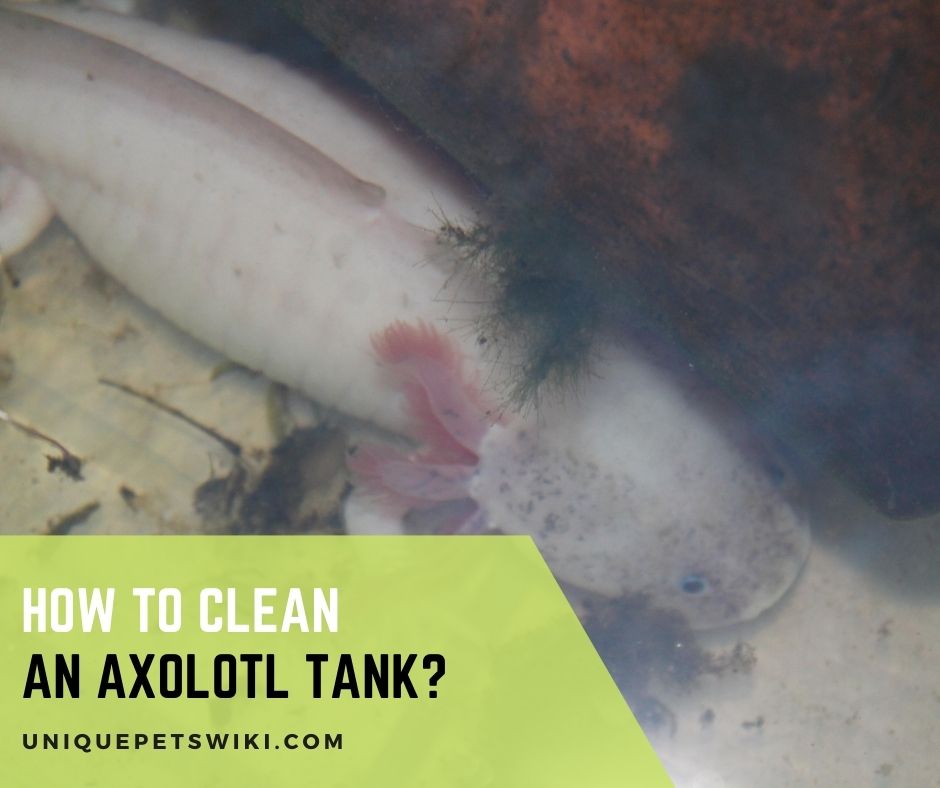The last thing you want is your axolotl to stay in a dirty tank. “How to clean an axolotl tank?” is a question that many axolotl owners have raised to us.
If you wish to have an axolotl as your companion animal, you should be ready for the commitment to cleaning their habitat.
Dirty tanks are the worst places axolotls can stay in because they harbor diseases and expose them to chronic stress.
If you are trying to find out how you can clean your axy’s tank, worry no more. This article delves deep into axolotl’s tank cleaning procedure.
8 Steps to Clean an Axolotl Tank
Since axolotls always need to be in a clean tank, it’s necessary to clean their habitat more frequently. Cleaning should be done in three ways: spot, daily, and monthly deep cleaning.
Sometimes you may feel that monthly deep cleaning is an additional work since you change the water in the tank every day and clean all accessories, but you mustn’t skip it.
No one wants to spend an entire day in the name of cleaning their pet’s habitat. Spending less time cleaning and still getting a squeaky-clean tank is every axolotl owner’s goal.
Cleaning an axolotl tank is an easy task involving five steps: preparation, axolotl transfer, removing part of the water, removing substrates and accessories, and then cleaning the tank.

Step 1: Preparing
So now you are so eager and ready to start cleaning your axolotl tank. But don’t be too quick to start the task yet; it’s time to collect all the tools and materials together.
It can cost you a lot of time going for this and that if you don’t get all the materials together from the beginning.
This step involves two contents, including preparing the tools/instruments and water.
For the instruments, you need a siphon or aquarium vacuum hose, a clean/freshwater source, two buckets (one if an aquarium vacuum attaches to the tap), a tub, and a turkey baster.
To prepare water, you need bottled water or dechlorinated tap water. How much water depends on your tank and how much water you intend to remove during cleaning.
For instance, if you remove 25% of the tank water, you need to replace it with the same amount. Allow the tap water to sit for 1-2 days for dichlorination; however, you can extend the time if your water source has a lot of chemicals.
Aqueon Aquarium Fish Tank Water Changer With 50 Foot Hose
- Makes routine water changes easier, eliminates spills and heavy lifting!
- Attaches to faucet: removes dirty water and can return clean water
- Vacuums out the debris in gravel right down the drain
- Simply turn on your faucet to begin siphon
- Be sure to add Aqueon Water Conditioner when adding clean water to aquarium
Last update on 2022-12-29 / Affiliate links / Images from Amazon Product Advertising API
Step 2: Transfer Axolotl
We hope you didn’t leave out a tub when assembling the cleaning materials. It’s time to use the tub now since this is where you will put your axolotl while cleaning the tank.
You have three options for transferring an axolotl from its tank to a tub: by hand, using a net, or container.
A hand or container works best when transferring larger and friendlier axies, while nets are good when dealing with baby axolotls.
A net proves to be more effective than using your hand or a container because it accommodates the axolotls well and doesn’t interfere with their breathing; you need a fine and spacious net.
The chances of injuring or hurting an axolotl when transferring it by the net are minimal. These animals have very delicate bodies that don’t require us to touch them whenever we want.
Marina 3-Inch Blue Fine Nylon Net with 10-Inch Handle
- Made with high quality materials; the soft nylon woven mesh material is perfect for gently scooping fish
- Allows for easy fish tank maintenance
- Great to use in either a freshwater fish tank or a salt water fishtank
- The aquarium fish net is 3”x3” (7.6 cm x 7.6 cm)
- Handle is 10” (25 cm) long; allows for easy reach
Last update on 2022-12-29 / Affiliate links / Images from Amazon Product Advertising API
Step 3: Remove Part of the Water
Anytime you’re cleaning your axolotl aquarium, never remove all water and scrub the entire tank because it will make the tank lose its nitrogen cycle. And if that happens, you will have no option but to start recycling the tank from zero.
A safe guideline for axolotl aquarium cleaning is to remove part of the water, which is 25% of the aquarium water. Insert one end of the siphon tube into the tank and the other end into a bucket to remove the water.
Some people may prefer to scoop the water with a container, but the container may contain contaminants that can dissolve in the tank.
Tetra Water Maintence Items for Aquariums – Makes Water Changes Easy
- TETRA WATER CLEANER: Gravel siphon used to easily clean aquariums.
- COMPATIBLE AQUARIUM SIZE: For aquariums up to 55 gallons.
- MAKES MONTHLY WATER CHANGES EASY: It only takes 30 minutes to replace 30% of water every 30 days.
- REMOVE DEBRIS: Siphons are a great way to easily remove debris from gravel by moving the water cleaner throughout the gravel.
- INCLUDED: Tetra Water Cleaner comes with gravel siphon, priming bulb and clip for bucket for a simple set up.
Last update on 2022-12-30 / Affiliate links / Images from Amazon Product Advertising API
Step 4: Remove Accessories and Substrates
Suck up poop and dirt that you spot in the tank using a turkey baster. For filtered aquariums, the filter is the one that cleans the water of debris.
But if you don’t have a filter, you can wait for the substrate and other waste materials to settle and then siphon them out. A thicker pipe than the average gravel cleaner hose should be able to suck up all substrate.
Step 5: Start Cleaning
Clean the aquarium with a clean cloth to remove any material sticking in the bottom, then use a turkey baster to suck the resulting waste. Also, wipe the tank sides dry.
For the accessories, clean them using 25% of the tank water you removed and scrub them with a toothbrush to clean algae.
Your goal is to keep the aquarium 100% free from chlorine and chlorinates; thus, you should be extremely careful when cleaning all the accessories. That has to do with the filter, too, because this is where beneficial bacteria build up.
Step 6: Add Accessories and Substrates
Put back the accessories in the tank after cleaning. Sometimes you can choose to reposition the accessories but check on your axolotl behavior. Some axolotls will be curious while others shy because of repositioning.
If you want to add substrate, fill a small bottle with sand (use a strainer funnel for easy loading) and cap it.
Hold the bottle upside down at the bottom of the tank and untwist the cap. The bottle will suck up some water to help expel the sand at the bottom. Squeeze the bottle slowly and randomly until all the sand is pushed out.
Step 7: Add Water
I hope you did not mistakenly pour the water we prepared earlier because this is what you will use to top up the tank.
Since we drained 25% of the tank water, we need to refill it with the same amount. Pour the freshwater slowly into the tank, or use a water-filling hose pipe (if it’s available).
Always confirm that the water you use to fill the tank and the one already in the tank has the same temperature to prevent axolotl temperature shock.
Step 8: Put Axolotl into the Tank
Now that you’re done with cleaning, it’s wise to test the water before you bring the axolotl back to the tank. Ensure the water chemistry is stable since that is the only way your axolotl will find its home comfortable.
A water testing kit helps to accurately monitor the water parameter levels in freshwater aquariums, including pH, nitrite, nitrate, and ammonia.
Warmer water is bad for axolotls, and so is too cold water. Keep the temperature at its ideal range. Then, transfer the axolotl back to the tank the way you removed it, using a net.
Let the axolotl swim out from the net and into the water, but don’t drop it. Observe the axolotl and see if they show any unusual signs after cleaning the tank.
API FRESHWATER MASTER TEST KIT 800
- Contains one (1) API FRESHWATER MASTER TEST KIT 800-Test Freshwater Aquarium Water Master Test Kit, including 7 bottles of testing solutions, 1 color card and 4 glass tubes with cap
- Helps monitor water quality and prevent invisible water problems that can be harmful to fish and cause fish loss
- Accurately monitors 5 most vital water parameters levels in freshwater aquariums: pH, high range pH, ammonia, nitrite, nitrate
- Designed for use in freshwater aquariums only
- Use for weekly monitoring and when water or fish problems appear
Last update on 2022-12-30 / Affiliate links / Images from Amazon Product Advertising API
Why Is My Axolotl Tank So Dirty?
An axolotl tank can get dirty, especially if you have more than one axolotl and rear them in a small tank. The more the axolotls, the more the waste makes the tank dirty quickly.
Moreover, not cleaning the tank often could be why it is so dirty. The tank will also be dirty when the filter strength is weak, and you go without cleaning for many days.
The tankmates’ waste, the leftovers, axolotls’ poop, and waste are the primary causes of dirty tanks. You should work hard on spot cleaning, and your axolotl’s tank will take longer to get dirty.
How Do I Keep My Axolotl Tank Clear?
To keep an axolotl’s tank clear, you should do a more frequent water change. Leaving the tank unclean makes ammonia accumulate to higher levels, which will be toxic to axolotls and can kill them.
Furthermore, getting a bigger tank is essential. The bigger the tank, the more water volume it holds, the more diluted the waste, and the clearer the water. Also, getting a bigger and more powerful filter can maintain water clarity.
Finally, using a turkey baster to suck up waste whenever you see them will ensure the tank stays clearer between water changes.

How Often Should You Clean an Axolotl’s Tank?
How often you clean your lotl’s aquarium will depend on several factors, including the tank size, tank type, frequency of feeding, volume, number of axolotls, and age & size of axolotls.
For instance, if you rear one axolotl in a spacious tank, there will be less concentration of waste, and if you have a powerful filter, you can change the tank water after a long time.
Tanks without a filter require regular and daily cleaning. Many axolotls in the same tank excrete a lot of waste that requires frequent cleaning to avoid accumulation.
Contrastingly, a cycled and biological axolotl tank reduces clean-up time.
Penn-Plax Cascade 1500 Aquarium Canister Filter
- CASCADE 1500 CANISTER FILTER: Without effort, the Cascade 1500 Canister Filter quietly delivers crystal clear water throughout the tank. This filter cycles water at 350 Gallons per Hour, and is recommended for aquariums up to 200 gallons. It’s compatible for both freshwater and saltwater fish tanks, and is also great for turtle habitats!
- STATE OF THE ART FEATURES: In addition to the push button primer that allows for a simple and quick prime, this Canister Filter also features two independent valve taps that rotate 360°. This makes for easy maneuvering, even in the tightest aquarium cabinets! The 5 stackable, large capacity media baskets give aquarists the ability to customize filtration.
- FILTER MEDIA: This Canister Filter comes standard with 5 Poly Fiber Floss Pads, 1 Coarse Bio-Sponge, and 1 Bag of Activated Carbon. In addition to optimizing the colonization of anaerobic bacteria, this filter traps floating particulate matter, removes harmful chemicals and toxins, clears up discolorations, and reduces foul odors from your aquarium’s water.
- ITEMS INCLUDED: 2 Independent Valve Taps, Push Button Primer, Flow Rate Control Cut-Off Valves, Swimming-Pool Style Hose Clamps, 4 Easy Lift Alignment Clamps, Sturdy Tip-Proof Base, 5 Large Capacity Media Baskets, 5 Poly Fiber Floss Pads, 1 Coarse Bio-Sponge, and 1 Bag of Activated Carbon.
- MEASUREMENTS AND OTHER USEFUL INFO: The Cascade 1500 Canister Filter measures 11.5” (W) x 12” (D) x 20.5” (H). Additional Info = 110 Volts / 60 Hz / 45.5 W.
Last update on 2022-12-29 / Affiliate links / Images from Amazon Product Advertising API
Wrapping Up
Among can be very messy if you don’t clean their tank routinely. They have a great deal of appetite, making them poop often. Poop and food remain the main causes of dirty tanks.
If the waste builds up, the tank will be unconducive for the axolotl to stay. Cleaning an axolotl tank should be a regular activity to provide a safe environment where the axolotl will be happy and healthy.
All the water that gets into the axolotl aquarium should be dechlorinated. Avoid using tap water no matter what is the circumstance.





